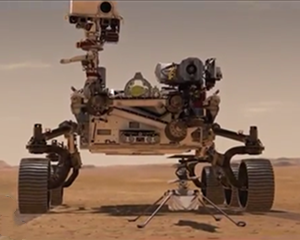AMNA NAWAZ: Well, NASA has made plenty of history with spaceflights to Mars, but, today, a new chapter: It flew on Mars for the very first time. Miles O'Brien takes us out of this world.
MAN: Altimeter data confirmed that Ingenuity has performed its first flight.
MILES O'BRIEN: When the data and the early images came down proving history was made 180 million miles away, the Mars Ingenuity team erupted with joy. Project manager MiMi Aung ripped up the contingency speech she wrote in case things did not go as well as they did. Ingenuity took off, hovered and landed on Mars, the first powered controlled flight on another planet.
MIMI AUNG, Project Manager, Mars Helicopter: We can now say that human beings have now flown a rotorcraft on another planet.
MILES O'BRIEN: Mars changes the equation for flight with wings or rotors. The gravity is about one-third of Earth's, and the carbon dioxide atmosphere is much thinner.
MIMI AUNG: It's about 1 percent compared to here right on Earth. Even though you're able to lift, right, you have to spin very fast to lift. Because the atmosphere is so thin you can't lift as much mass.
MILES O'BRIEN: Here on Earth, helicopter blades typically spin about three or 400 revolutions per minute. Ingenuity's blades spin at about eight times faster, 2,400 RPMs. The key challenge for the team, make the helicopter as small and light as possible to fit on Perseverance and to be flight-worthy. To find compact components, they didn't have to look much farther than their own smartphones.

MIMI AUNG: The advancement of the cellular phone technologies, and, also, autonomous cars are also starting to have reliable lightweight sensors, right, and their lightweight computers on their phones. And drone community has also advanced electronic components.
MILES O'BRIEN: Ingenuity is a technology demonstrator, so its goals are modest. The plan is to fly only five flights, no higher than 15 feet, no farther than 160 feet downrange, and no longer than a minute-and-a-half. If history serves as a guide, Ingenuity could usher in a new era of mobile exploration on Mars.
WOMAN: We have imaging data.
MAN: Yes!
MILES O'BRIEN: In 1997, the first Mars rover, Sojourner, was also a technology demonstration project. The size of a microwave oven, it led to larger and more capable successors, Spirit and Opportunity in 2003, Curiosity in 2012, and now Perseverance. Lori Glaze is director of NASA's Planetary Science Division.
LORI GLAZE, Director, NASA Planetary Science Division: The helicopters can actually help to do reconnaissance, to scope out a new site or actually to access places that we can't actually access, to collect samples, potentially, or carry scientific instrumentation to do some institute science from the helicopter.
MILES O'BRIEN: Just as it was 118 years ago at Kitty Hawk, this first flight is likely just the beginning of a new era of aviation. For the "PBS NewsHour," I'm Miles O'Brien.












